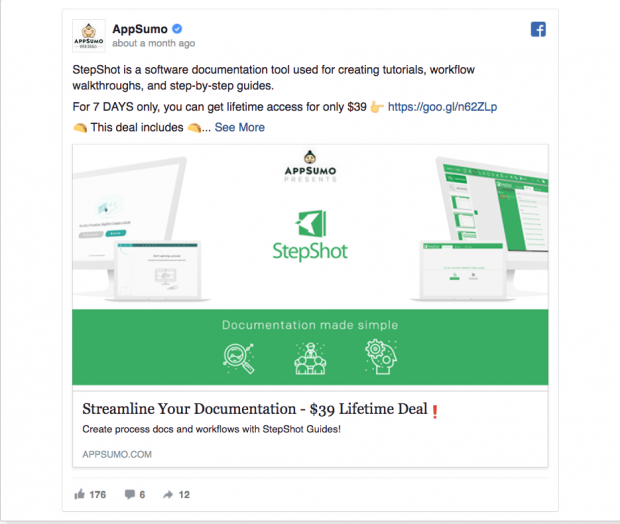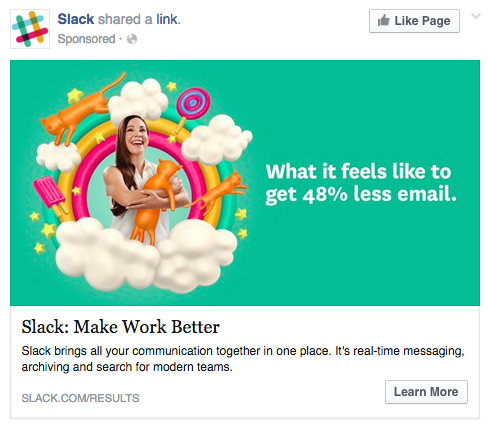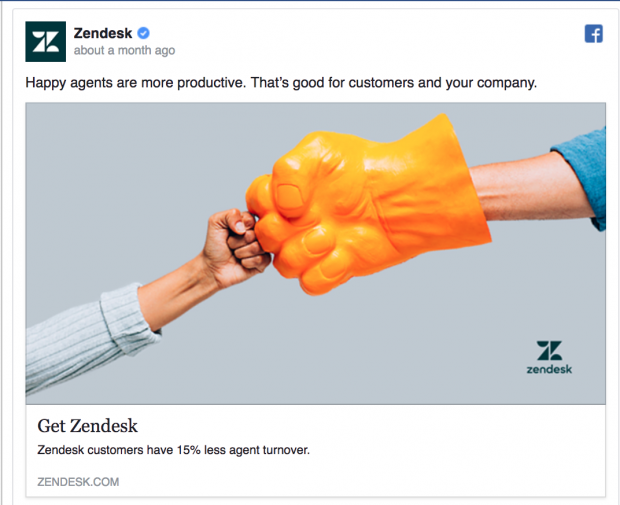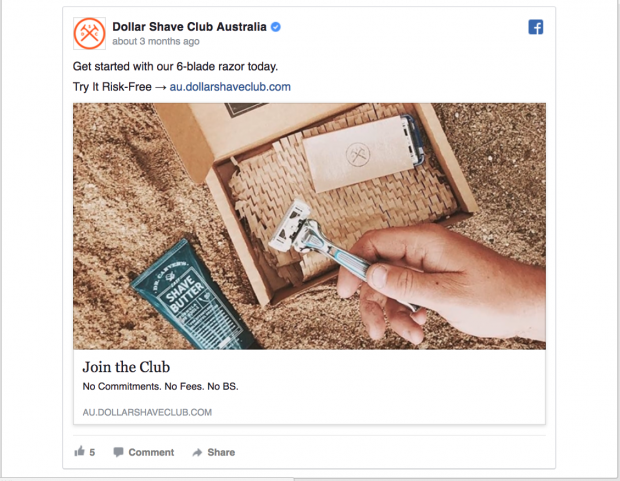It’s simple to get confused with Facebook advertising. From behavioral focusing on pixel tracking, Facebook provides a bewildering number of targeting options, advertising greatest practices, and advert formats.
In this article, you will learn the 5 elements of the perfect Facebook ad. I will walk you through each step. These lessons are based on things we have learned at Hootsuite running paid social advertising campaigns.
1. Create a simple CTA with one clear action
The perfect Facebook ad is clear about the action it wants the prospect to take.
Every marketing campaign or advert format in the world could be boiled down into two kinds: adverts designed to engage your prospect’s attention and adverts designed to drive a direct action like sale, app install or lead.
In a perfect world, your marketing campaign does both. However, in most cases, you will either get one or the other. Brand awareness is valuable. It is a smart strategy that builds your enterprise over the long-term. However, too many campaigns attempt to mash brand awareness and direct response together. Unless you are a marketing genius, it hardly ever works.
As such, creative brand awareness campaigns are better served with CTAs associated with content material consumption like following your Fb page, subscribing for more content, or collecting email subscriptions. And direct response adverts are better served to answer common buying objections than attempting to engage or entertain.
A superb instance of a direct response advert comes from the company AppSumo. As you could see below, the perfect Facebook ad has one clear purpose: get you to immediately purchase the product.
The perfect Facebook ad does not waste time—it tells what the product is, what the deal includes, and uses a timed offer to provide you with a compelling reason to purchase right away.
Mailchimp is the undisputed champion of brand advertising. Their genius is that they let brand awareness campaigns simply build the brand. Their Fb adverts never attempt to get you to watch one of their weirdly brilliant videos AND sign up for a free trial. It’s not that Mailchimp doesn’t do product-specific adverts, either. A lot of their adverts purpose to drive sales or get customers to attempt a new function. However, they keep these two worlds—brand awareness and direct response—completely separated.
Conversely, an advert that tries to do both is likely to fall flat. When you have advert copy that speaks to the core value of your product (brand awareness), do not ask people to purchase or sign up right away. Instead, use your CTA to encourage people to take a smaller, more location action like “watch a video to learn how the product works.”
Decide on one simple action you want people to take. The simplest method is to focus your advert on one section of the purchase funnel.
- Awareness, affinity, and consumption: stick to first handshake CTAs like boosting followers, reading other pieces of content material, or subscribing to your email.
- Conversation: concentrate on engagement metrics similar to boosting shares, rising comments, and tagging, or generating positive mentions.
- Intent: concentrate on next step CTAs like “learn more” or driving content downloads.
- Conversion: concentrate on actions that lead directly to revenue like including products to a cart, requesting a sales demo, downloading an app, or signing up for a subscription product.
2. Use an audience targeting strategy that helps you refine over time
The perfect Facebook ad does not blindly mix audience focusing on. It uses testing to refine focusing on precision over time.
Fb provides an endless list of viewers focusing on abilities. It’s simple to get confused. And even simpler to just give up, including random interest and behavior categories and hoping that Fb will magically match you with customers.
You could save lots of money and time by being intentional in your audience targeting.
The trick to audience targeting is to enhance your insights into what works over time.
Right here’s an easy path to begin.
Start with a lookalike audience.
Lookalike audiences are highly effective because you could use existing data (like people who bought a product from your website) to focus on similar prospects on Facebook. This provides you with a solid platform to begin testing and refining your audience targeting.
How do you create a lookalike audience on Facebook? In your favorite Facebook ad tool, follow these steps.
- Navigate to the Audience section of your adverts manager.
- Click on Create a Lookalike Audience.
- Select create a custom audience and then select customer file.
- You could then add an Excel file of customers—for instance, your email list or a list of customers from PayPal.
- Select the country where you would like to discover a similar set of people.
- Select your desired audience size with the slider.
- Click on Create Audience.
In case your purpose is to focus on the most potential lead prospects, you need to create lookalike audiences targeting one to 2 % of a country’s population, instead of aiming for 10 %. And for greatest outcomes, do not forget to exclude custom audiences of people who have already converted.
Later, refine with nuanced targeting.
After you run your first marketing campaign, you could then adjust your audience targeting strategy by including the tweaks below. Add these one at a time to see if they make an impact.
First, select the target location. Then add on interests. Then demographics. Narrow your audience by including required categories—like the user have to be excited about X and also must like Y or Z. Experiment with behaviors as well.
Under behaviors, you could target particular device owners, people who are having an anniversary within the next 2 years, for instance, or users who’ve recently made a business purchase.
Another method is to begin by testing broad audiences, after which including extra specifics as you go, getting a extra refined and better changing viewers each time.
3. Write a transparent and conversational headline
The perfect Facebook ad does not annoy people with boring advantages or wordy gross sales pitches. Use a conversational tone and chill out on the gross sales tips.
We’ve found that headlines work best after they are clear and conversational. This minimizes annoying individuals with overt promoting of their private feeds.
Typically headline is a clever phrase. Different occasions, it is a simple product profit. There aren’t any true hacks to writing headlines. And even the outdated suggestion that headlines need to comprise benefits—not options—is as the British say, rubbish.
My advice is to observe manufacturers that basically have mastered the aesthetic and social codes of Facebook and Instagram. A number of private favorites: Chewy.com, MVMT, and <>. You will uncover these manufacturers are inclined to have a lot conversational method to headlines, reasonably than conventional benefit-focused copy.
As an apart, your headline in a Facebook ad is usually the “textual content” subject within the advert builder, not the “headline” subject. I and Zuck see eye-to-eye on many things. However, it is clear that engineers—not copywriters—constructed Facebook ads.
As you may need to be seen in Fb’s advert builder, the ‘headline’ appears within the third place within the ad underneath the image. This is able to make the headline the second factor you learn within the ad—so not a headline in any respect.
In the event you enter copy within the “textual content” subject, cope with this as your headline. It is the very first thing your prospects will see and the “headline” capabilities extra like a subhead for extra data.
4. Use an image that has inventive stress with the headline
The perfect Facebook ad has clever or inventive stress between artwork and replica.
Amatuer advertisers on Facebook make a predictable mistake. The image and the headline have no inventive stress. For example, if the headline is “make cash in your sleep,” you will see an inventory image of an individual in pajamas, holding handfuls of cash. Or if the headline says “turn into a social media jedi” you will see a social media supervisor dressed as a jedi.
Right here is a helpful rule for stronger artwork route. If the copy is literal, make the visible playful. If the visible is playful, make the copy literal. This makes distinction and interaction between the artwork and the replica.
For example, Slack’s well-known marketing campaign has a summary image. The headline is copied is easy, explaining the metaphor. This is able to be a lot completely different marketing campaign if the image was additionally simple and literal similar to an individual in a workplace getting a high-five. It is the strain between the image and headline that creates the advert attention-grabbing.
One other instance comes from Zendesk. Think about how horrible the advert beneath could be if the image was changed with a smiling staff of assist brokers. A literal headline and a literal image that makes for lifeless promoting.
When you have to be visually impressed, you need to use AdEspresso’s free ad tool. It allows you to spy on opponents and uncover profitable examples of Facebook ads.
5. Use the outlined space to take away friction on your CTA
The perfect Facebook ad is aware of that asking individuals to finish a motion all the time makes purchaser anxiousness.
Your closing step is to write down the outline on your CTA. That’s the Info Feed Hyperlink Description. Use this area to anticipate widespread shopping for objections.
For example, in case your CTA is “Obtain your report” a standard objection might the viewers questioning the worth of the report.
As you possibly could see beneath, the Greenback Shave Membership makes use of the outlined space to reply widespread objections to their subscription bundle.
So you possibly could add some specific particulars similar to a teaser of the content material. In the event you are asking for a direct sale—similar to adđing a product to a procuring cart—you possibly could point out free transport or return insurance policies to make the perfect Facebook ad.





